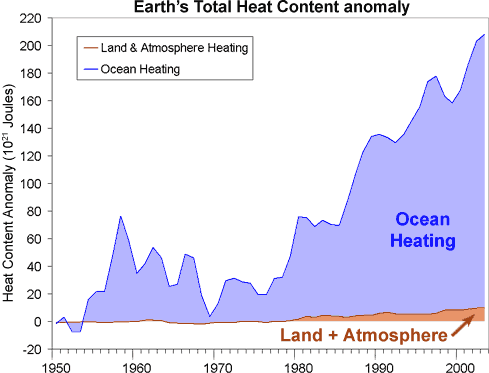ScienceRocks
Democrat all the way!
- Banned
- #1
2011 9th Warmest Year in Satellite Record
January 4th, 2012 at 10:16 pm by Jim Spencer under Weather
2011 9th Warmest Year in Satellite Record | KXAN.com Blogs
Global Temperature Report: December 2011
Global climate trend since Nov. 16, 1978: +0.13 C per decade
December temperatures (preliminary)
Global composite temp.: +0.13 C (about 0.23 degrees Fahrenheit) above 30-year average for December.
Northern Hemisphere: +0.20 C (about 0.36 degrees Fahrenheit) above 30-year average for December.
Southern Hemisphere: +0.06 C (about 0.11 degrees Fahrenheit) above 30-year average for December.
Tropics: +0.04 C (about 0.07 degrees Fahrenheit) above 30-year average for December.
(All temperature anomalies are based on a 30-year average (1981-2010) for the month reported.)
Notes on data released Jan. 4, 2012:
2011 was the ninth warmest year (globally averaged) in the 33-year global satellite record despite La Niña Pacific Ocean cooling events at the start and finish of the year, according to John Christy, a professor of atmospheric science and director of the Earth System Science Center (ESSC) at The University of Alabama in Huntsville. Globally averaged, Earth’s atmosphere was 0.15 C (0.27 degree Fahrenheit) warmer than the 30-year average in 2011; That was less than half of the warming anomaly seen in 2010.
Average annual global
temperature anomalies,
warmest to coolest
1979 – 2011
1998 0.424
2010 0.411
2005 0.251
2002 0.22
2009 0.187
2003 0.185
2006 0.175
2007 0.168
2011 0.15
2001 0.112
2004 0.104
1991 0.025
1987 0.018
1995 0.018
1988 0.017
1980 -0.003
1990 -0.017
1981 -0.04
2008 -0.041
1997 -0.044
1999 -0.051
1983 -0.056
2000 -0.056
1996 -0.071
1994 -0.104
1979 -0.165
1989 -0.202
1986 -0.239
1993 -0.24
1982 -0.245
1992 -0.284
1985 -0.304
1984 -0.348
With A COLDER SET UP for 2011 we got 9th, while 2008 had the 19th coldest at 2008 -0.041c. 2011 had a double nina...That hasn't happened since 1999-2001 nina cycle. The first nina in 2008 may of been close to the first one, but we didn't go below -.5c globally or even a offical second nina. This year we made -1.0 or moderate for the second nina and never warmed up at all.
This year was a impressive .191c warmer then 2008!
Ladies and gents, if this year couldn't knock us outside of the 10th warmest years-- we aren't ever going to see another in are life times. Seriously, no nina event since 1974 was as strong. Yes, sir we just faced down one of the coldest patterns in 40 years in laughed in its face! A pattern that could of put us near 1984-1985 or lower on that list.
January 4th, 2012 at 10:16 pm by Jim Spencer under Weather
2011 9th Warmest Year in Satellite Record | KXAN.com Blogs
Global Temperature Report: December 2011
Global climate trend since Nov. 16, 1978: +0.13 C per decade
December temperatures (preliminary)
Global composite temp.: +0.13 C (about 0.23 degrees Fahrenheit) above 30-year average for December.
Northern Hemisphere: +0.20 C (about 0.36 degrees Fahrenheit) above 30-year average for December.
Southern Hemisphere: +0.06 C (about 0.11 degrees Fahrenheit) above 30-year average for December.
Tropics: +0.04 C (about 0.07 degrees Fahrenheit) above 30-year average for December.
(All temperature anomalies are based on a 30-year average (1981-2010) for the month reported.)
Notes on data released Jan. 4, 2012:
2011 was the ninth warmest year (globally averaged) in the 33-year global satellite record despite La Niña Pacific Ocean cooling events at the start and finish of the year, according to John Christy, a professor of atmospheric science and director of the Earth System Science Center (ESSC) at The University of Alabama in Huntsville. Globally averaged, Earth’s atmosphere was 0.15 C (0.27 degree Fahrenheit) warmer than the 30-year average in 2011; That was less than half of the warming anomaly seen in 2010.
Average annual global
temperature anomalies,
warmest to coolest
1979 – 2011
1998 0.424
2010 0.411
2005 0.251
2002 0.22
2009 0.187
2003 0.185
2006 0.175
2007 0.168
2011 0.15
2001 0.112
2004 0.104
1991 0.025
1987 0.018
1995 0.018
1988 0.017
1980 -0.003
1990 -0.017
1981 -0.04
2008 -0.041
1997 -0.044
1999 -0.051
1983 -0.056
2000 -0.056
1996 -0.071
1994 -0.104
1979 -0.165
1989 -0.202
1986 -0.239
1993 -0.24
1982 -0.245
1992 -0.284
1985 -0.304
1984 -0.348
With A COLDER SET UP for 2011 we got 9th, while 2008 had the 19th coldest at 2008 -0.041c. 2011 had a double nina...That hasn't happened since 1999-2001 nina cycle. The first nina in 2008 may of been close to the first one, but we didn't go below -.5c globally or even a offical second nina. This year we made -1.0 or moderate for the second nina and never warmed up at all.
This year was a impressive .191c warmer then 2008!
Ladies and gents, if this year couldn't knock us outside of the 10th warmest years-- we aren't ever going to see another in are life times. Seriously, no nina event since 1974 was as strong. Yes, sir we just faced down one of the coldest patterns in 40 years in laughed in its face! A pattern that could of put us near 1984-1985 or lower on that list.
Last edited:


